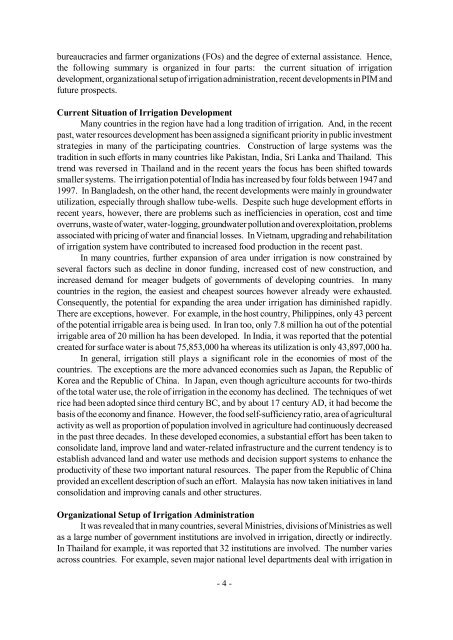Organizational Change for Participatory Irrigation Management
Organizational Change for Participatory Irrigation Management
Organizational Change for Participatory Irrigation Management
Create successful ePaper yourself
Turn your PDF publications into a flip-book with our unique Google optimized e-Paper software.
ureaucracies and farmer organizations (FOs) and the degree of external assistance. Hence,<br />
the following summary is organized in four parts: the current situation of irrigation<br />
development, organizational setup of irrigation administration, recent developments in PIM and<br />
future prospects.<br />
Current Situation of <strong>Irrigation</strong> Development<br />
Many countries in the region have had a long tradition of irrigation. And, in the recent<br />
past, water resources development has been assigned a significant priority in public investment<br />
strategies in many of the participating countries. Construction of large systems was the<br />
tradition in such ef<strong>for</strong>ts in many countries like Pakistan, India, Sri Lanka and Thailand. This<br />
trend was reversed in Thailand and in the recent years the focus has been shifted towards<br />
smaller systems. The irrigation potential of India has increased by four folds between 1947 and<br />
1997. In Bangladesh, on the other hand, the recent developments were mainly in groundwater<br />
utilization, especially through shallow tube-wells. Despite such huge development ef<strong>for</strong>ts in<br />
recent years, however, there are problems such as inefficiencies in operation, cost and time<br />
overruns, waste of water, water-logging, groundwater pollution and overexploitation, problems<br />
associated with pricing of water and financial losses. In Vietnam, upgrading and rehabilitation<br />
of irrigation system have contributed to increased food production in the recent past.<br />
In many countries, further expansion of area under irrigation is now constrained by<br />
several factors such as decline in donor funding, increased cost of new construction, and<br />
increased demand <strong>for</strong> meager budgets of governments of developing countries. In many<br />
countries in the region, the easiest and cheapest sources however already were exhausted.<br />
Consequently, the potential <strong>for</strong> expanding the area under irrigation has diminished rapidly.<br />
There are exceptions, however. For example, in the host country, Philippines, only 43 percent<br />
of the potential irrigable area is being used. In Iran too, only 7.8 million ha out of the potential<br />
irrigable area of 20 million ha has been developed. In India, it was reported that the potential<br />
created <strong>for</strong> surface water is about 75,853,000 ha whereas its utilization is only 43,897,000 ha.<br />
In general, irrigation still plays a significant role in the economies of most of the<br />
countries. The exceptions are the more advanced economies such as Japan, the Republic of<br />
Korea and the Republic of China. In Japan, even though agriculture accounts <strong>for</strong> two-thirds<br />
of the total water use, the role of irrigation in the economy has declined. The techniques of wet<br />
rice had been adopted since third century BC, and by about 17 century AD, it had become the<br />
basis of the economy and finance. However, the food self-sufficiency ratio, area of agricultural<br />
activity as well as proportion of population involved in agriculture had continuously decreased<br />
in the past three decades. In these developed economies, a substantial ef<strong>for</strong>t has been taken to<br />
consolidate land, improve land and water-related infrastructure and the current tendency is to<br />
establish advanced land and water use methods and decision support systems to enhance the<br />
productivity of these two important natural resources. The paper from the Republic of China<br />
provided an excellent description of such an ef<strong>for</strong>t. Malaysia has now taken initiatives in land<br />
consolidation and improving canals and other structures.<br />
<strong>Organizational</strong> Setup of <strong>Irrigation</strong> Administration<br />
It was revealed that in many countries, several Ministries, divisions of Ministries as well<br />
as a large number of government institutions are involved in irrigation, directly or indirectly.<br />
In Thailand <strong>for</strong> example, it was reported that 32 institutions are involved. The number varies<br />
across countries. For example, seven major national level departments deal with irrigation in<br />
- 4 -
















